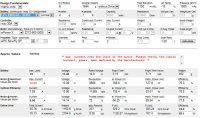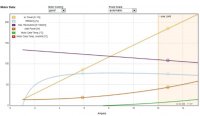helloman1976
Ziptie Relocation Expert
I have a DJI F550 knock-off and it weights in at about 3.5-4lbs fully loaded. I was using 750Kv 250W Turnigy NTM motors from Hobbyking and I have recently replaced those with much faster 1350Kv 310W Turnigy NTM motors also from Hobbyking and here's what I've discovered. I'm spinning the exact same APC 10"x5 pitch propellers and I used the same ones in each test. I found the following...
The 750Kv
More lifting power and more "punch" under weight
They never, ever, ever even got luke warm
Significantly less power draw (max wattage was 950W with a burst high of 1280W)
Flight time with 8,000mah battery was about 12-15 minutes
The 1350Kv
More speed hands down
Much more nimble
Excellent wind recovery and can fly in 35mph gusts with little corrections other than into the wind somewhat
Uses more power (max wattage 1,400W with burst high of 2440W)
Flight time is lower now to around 10-12 minutes
They get warm to hot but never burning hot and I tested them under severe conditions of up and down max to low power over and over to heat them up as much as possible....they get pretty warm like that though.
My thoughts....
I think with the 750Kv they weren't working very hard and since they are able to spin MUCH bigger blades they were basically idle but at the same time I was not able to pull their max power no matter what because of that so I shorted myself some flight power.
With the 1350Kv they are almost too powerful and I believe are working too hard with the 10"x5 props and would probably do better with 9x5 really.
My theory is that the 1000Kv motors are the way to go because they should have more torque than the 1350Kv but use less power like the 750Kv because they are able to spin 10x5 with no problems. I'll try to keep this post updated and refresh it when I get the 1000Kv's installed.......Hope that helps someone.
The 750Kv
More lifting power and more "punch" under weight
They never, ever, ever even got luke warm
Significantly less power draw (max wattage was 950W with a burst high of 1280W)
Flight time with 8,000mah battery was about 12-15 minutes
The 1350Kv
More speed hands down
Much more nimble
Excellent wind recovery and can fly in 35mph gusts with little corrections other than into the wind somewhat
Uses more power (max wattage 1,400W with burst high of 2440W)
Flight time is lower now to around 10-12 minutes
They get warm to hot but never burning hot and I tested them under severe conditions of up and down max to low power over and over to heat them up as much as possible....they get pretty warm like that though.
My thoughts....
I think with the 750Kv they weren't working very hard and since they are able to spin MUCH bigger blades they were basically idle but at the same time I was not able to pull their max power no matter what because of that so I shorted myself some flight power.
With the 1350Kv they are almost too powerful and I believe are working too hard with the 10"x5 props and would probably do better with 9x5 really.
My theory is that the 1000Kv motors are the way to go because they should have more torque than the 1350Kv but use less power like the 750Kv because they are able to spin 10x5 with no problems. I'll try to keep this post updated and refresh it when I get the 1000Kv's installed.......Hope that helps someone.
Last edited by a moderator:


